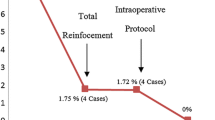Abstract
Background
Anastomotic bleeding following stapled left-sided colorectal resections is uncommon. There have been few reports on the incidence, severity, management and outcome of such stapled line haemorrhage in the literature. Here, we report our experience of anastomotic bleeding from a stapled anastomosis in laparoscopic left-sided colorectal surgery.
Methods
Data were collected prospectively on all patients undergoing laparoscopic colorectal surgery from 2003. Patients who had a left-sided stapled anastomosis requiring intervention for staple line haemorrhage were studied. Patients who underwent laparoscopic surgery for benign colorectal disease were compared with those who underwent laparoscopic surgery for a malignant condition. Risk factors for bleeding, management and outcome are reported.
Results
Over a 5-year period, 143 patients underwent laparoscopic left-sided colorectal surgery, 72 for benign disease and 71 for a malignant condition. Postoperative anastomotic bleeding occurred in six patients (4%). All were in the benign pathology group, and all had preservation of the inferior mesenteric artery during surgery. None of the patients required operative intervention for staple line haemorrhage.
Conclusions
Anastomotic bleeding from a stapled anastomosis in laparoscopic left-sided colorectal surgery is an infrequent complication and it may be more common with preservation of the inferior mesenteric artery. In the majority, bleeding is self limiting and will settle with nonoperative means. Endoscopic procedures may be useful for confirmation of bleeding and for therapeutic intervention, and may avoid the need for surgical intervention.
Similar content being viewed by others
References
Moran BJ (1996) Stapling instruments for intestinal anastomosis in colorectal surgery. Br J Surg 83:902–909
Steichen FM, Ravitch MM (1973) Mechanical sutures in surgery. Br J Surg 60:191–197
Matos D, Atallah AN, Castro AA, Lustosa SA (2001) Stapled versus handsewn methods for colorectal anastomosis surgery. Cochrane Database of Systematic Reviews, Issue 3. Article no.: CD003144. DOI: 10.1002/14651858.CD003144
Beart RW Jr, Kelly KA (1981) Randomised prospective evaluation of the EEA stapler for colorectal anastomoses. Am J Surg 141:143–147
Waxman BP, Yii MK, Pahlman L (1995) Stapling in colorectal surgery. In: Mazier WP, Levien DH, Luchtefeld MA, Senagore A (eds) Surgery of the colon, rectum and anus. WB Saunders, Philadelphia, pp 778–811
NICE (2006) Laparoscopic surgery for colorectal cancer (technology appraisal guidance no. 105). National Institute for Health and Clinical Excellence, London
Jex RK, van Heerden JA, Wolff GB et al (1987) Gastrointestinal anastomoses — factors affecting early complications. Ann Surg 206:138–141
Wassner JD, Yohai E, Heimlich HJ (1977) Complications associated with the use of gastrointestinal stapling devices. Surgery 82:395–399
Aurello P, D’Angelo F, Pozzi G et al (1991) Terapia dell’emorragia anastomotica massiva dopo resezione retto-coloca anteriore meccaninica. Giorn Chir 12:164–165
Malik AH, East JE, Buchanan GN, Kennedy RH (2008) Endoscopic haemostasis of stapled-line haemorrhage following colorectal resection. Colorectal Dis 10:616–618
Hsu TC (2007) Inferior mesenteric artery stump pressure is an unreliable predictor of the outcome of colorectal anastomosis. Int J Colorectal Dis 22:1481–1484
Cirocco WC, Golub RW (1995) Endoscopic treatment of postoperative hemorrhage from a stapled colorectal anastomosis. Am Surg 61:460–463
Atabek U, Pello MJ, Spence RK (1992) Arterial vasopressin for control of bleeding from a stapled intestinal anastomosis. Report of two cases. Dis Colon Rectum 35:1180–1182
Perez RO, Sousa A Jr, Bresciani C et al (2007) Endoscopic management of postoperative stapled colorectal anastomosis hemorrhage. Tech Coloproctol 11:64–66
Sung JJ, Tsoi KK, Lai LH et al (2007) Endoscopic clipping versus injection and thermo-coagulation in the treatment of non-variceal upper gastrointestinal bleeding: a meta-analysis. Gut 56:1364–1373
Sciumè C, Geraci G, Pisello F et al (2006) Infrequent early complication of mechanical digestive anastomosis: bleeding. Personal experience. Ann Ital Chir 77:269–272
Author information
Authors and Affiliations
Corresponding author
Rights and permissions
About this article
Cite this article
Linn, T.Y., Moran, B.J. & Cecil, T.D. Staple line haemorrhage following laparoscopic left-sided colorectal resections may be more common when the inferior mesenteric artery is preserved. Tech Coloproctol 12, 289–293 (2008). https://doi.org/10.1007/s10151-008-0437-3
Received:
Accepted:
Published:
Issue Date:
DOI: https://doi.org/10.1007/s10151-008-0437-3




